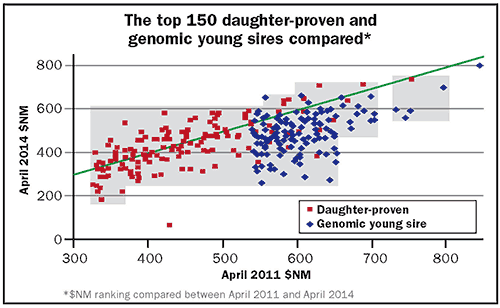
"Do not compare proven sires PTAs to genomic PTAs. Only compare them within their contemporaries for rankings," cautioned Chad Dechow when presenting "The new world of genetics" during the monthly Hoard's Dairyman webinar. He covered genomics and crossbreeding in his hour-long presentation.
Genomics
Since debuting in January of 2009, over 120,000 Holstein and 20,000 Jersey females have been genomically tested. Comparatively, fewer males have been tested as just 18,000 Holstein bulls have genomic tests. Brown Swiss and Ayrshire also have tests, but with smaller cattle populations, generating a significant pool is difficult. Despite the advent of genomics, the number of bulls entering artificial insemination programs has remained constant, with approximately 2,000 bulls each year.
Generation intervals have declined due to technologies like embryo transfer, in vitro fertilization and now genomics. While calves on the ground used to have sires who were nearly 7 years old when born, they are now just over three years old. The dam age difference is not as significant, dropping from 4.5 years to just over 3 years.
"Overestimates shouldn't surprise us because no gene functions independently," reminded Dechow. There is some bias in genomic results with overestimation of young sires, but they are reasonably accurate.

Many of the young sires were overestimated when compared to the sire summaries generated from their actual daughter data. There weren't dramatic shifts, but it was an overriding trend. To dig deeper into this topic, read "Bias remains a challenge for genomic evaluations" by Dechow in the May 25, 2014 issue of Hoard's Dairyman.
Part of the overestimation comes with the actual data calculation. Raw genomic data is added to parent values to generate the published values we see. That parent value is what contributes to much of the genomic young sire bias, especially from their young dams. But, some traits are more difficult to evaluate genomically, like productive life. Milking daughters provide a clearer reflection of this trait.
Genomic testing also identifies genes that contribute to milk components, such as predicted fat levels in milk. These types of discoveries will be interesting to watch.
Future of genomics
Genomics don't tell us everything, but we are learning. Dechow encouraged herd owners to genetically test their herd at least once. "You'll be surprised with higher-than-expected sire misidentification you'll uncover (even on well-managed farms)." But, the greater reward is having a genetic value for each animal for benchmarking, analysis and comparisons.
Look for an upcoming blog on genomic breeding strategies and crossbreeding.
The August presentation was brought to you by Neogen Corporation. (www.neogen.com/agrigenomics) This August webinar is archived and available for viewing. Past webinars can be found at www.hoards.com/webinars.

The author is the online media manager and is responsible for the website, webinars and social media. A graduate of Modesto Junior College and Fresno State, she was raised on a California dairy and frequently blogs on youth programs and consumer issues.









